CBC Compass broke the story last night that the Charlottetown Area Development Corporation has been secretly developing a plan to extend the Queen Parkade across through to University Avenue, tearing down the buildings that house the The Maple Grill, Back Alley Music, Monsoon, the Alibi Lounge and Cedar’s in the process.
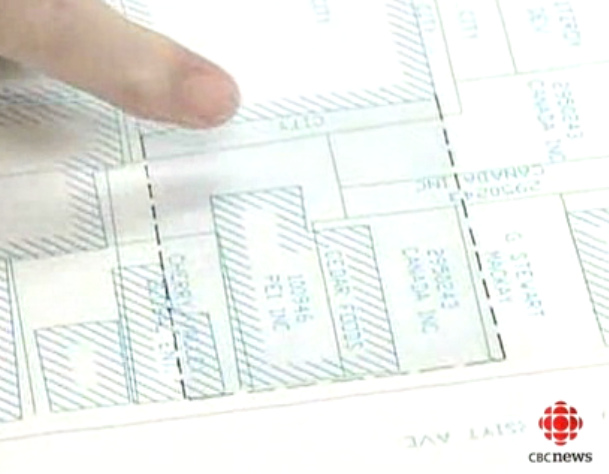
| Turning this… | Into more of this… |
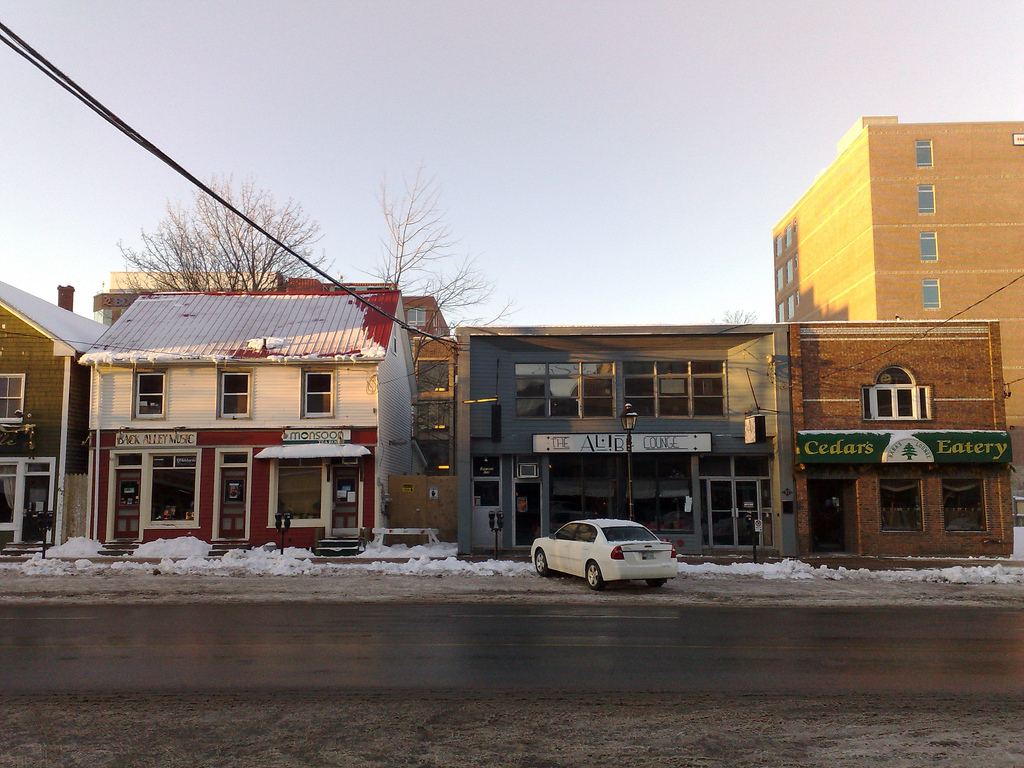 |
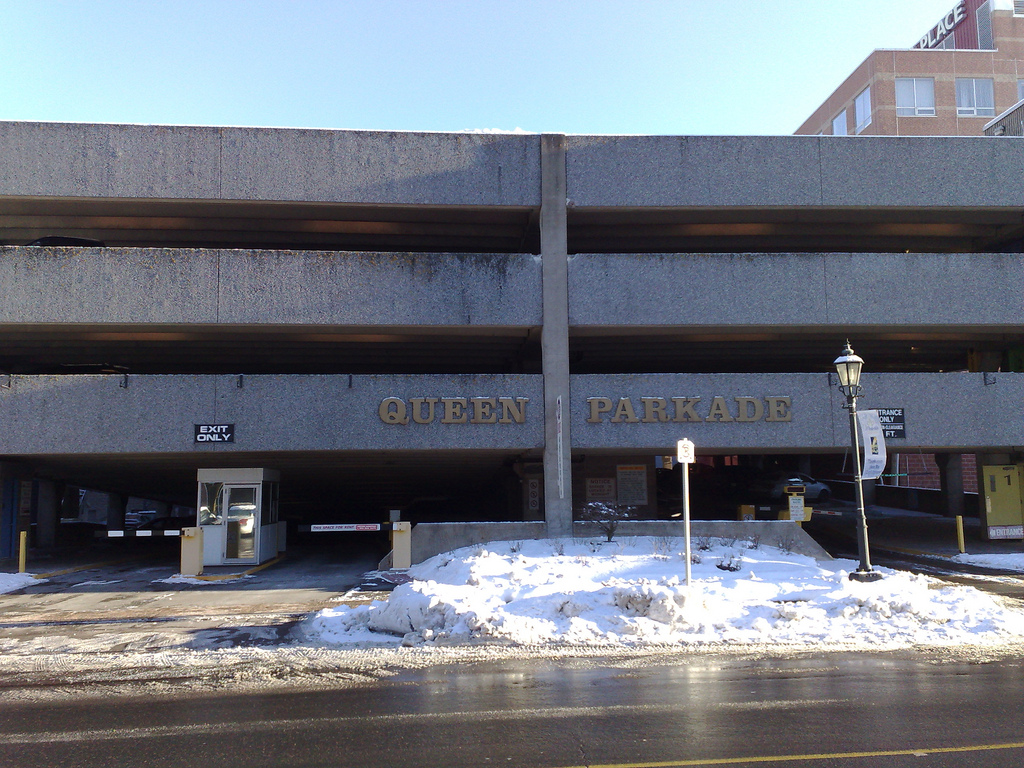 |
This is being done, CBC reports, to provide 200 parking spaces for the new Homburg developments downtown.
Fortunately the owners whose properties were to fall to the wrecking ball, or at least some of them, decided not to sell to CADC and so the plan has been scrapped, at least for the time-being, in favour of expanding either the Fitzroy or Pownal parkades.
While the immediate threat has been stanched, the larger issue – just how far is the City of Charlottetown willing to prostrate itself at the alter of Homburg’s Trump-like plans to remake the city’s core in his own image – remains.
Indeed this plan, conceived out of the public’s scrutiny under cover of CADC’s “arm’s length” relationship to both the city and the province, represents a new, more foreboding variety of Homburgism: it was possible to argue, however implausibly, the Homburg’s developments to date, the office skyscraper and the hotel, benignly replaced underused buildings.
In this case, however, CADC, doing Homburg’s bidding, was proposing to tear down an entire stretch of viable businesses so that Homburg’s tenants would have a more convenient place to park.
This is no longer development, it’s cannibalism, and it must be stopped.
There’s an larger issue at play here too, and that’s the rapid disappearance of what Stewart Brand calls “low road buildings” – the cheap, flexible, unremarkable buildings in any city that play a vital role as incubators of small businesses that would be impossible to house anywhere else.
We lost a strip of low road storefronts when the Jean Canfield Building went up between Fitzroy and Euston on University Ave., another when the Johnny’s Mayfair building burned at the corner of Prince and Kent, and as Water Street gradually gentrifies we’re losing even more down there.
Without low road buildings in the core you don’t get record stores and sushi places and bicycle shops and book stores and interesting bars, you get franchises and banks and office towers and high-end shoe stores.
If the trend continues, there won’t be any area downtown for small businesses to bootstrap, and it’s precisely this kind of small business that breathes new life and diversity into the retail and restaurant life of the city, and that distinguishes downtown Charlottetown from downtown anywhere else.
I grew up in Ontario during the decades when “urban core renewal” was in vogue, a style of “renewal” that saw the downtown of many small cities – Brantford, Hamilton, and Peterborough come to mind, but there are countless others – gutted and replaced with behemothic shopping malls. The result? Much fanfare, followed by a gradual decline into urban wasteland.
While Charlottetown was not completely immune to this trend, the city was fortunate that the shopping mall we got downtown preserved much of the existing infrastructure, and so was less behemothic and more sympathetic infill.
But even this less severe approach to “renewal” has essentially been a failure: you have only to walk through what remains of the Confederation Court Mall and its empty unit after empty unit to see this.
And yet those charged with charting a course for the Charlottetown have fallen in thrall to Homburgism, a model of the city that, if it prevails, will ultimately see much of what’s interesting and unique about the city replaced with generic developments that flow from one man’s outlandish vision, not from the kind of collaborative, organic, community-based planning process that makes the kind of city that people might actually want to live in.
While the thwarting of CADC plan to expand the Queen Parkade holds back one flank of this battle, it continues on other fronts unabated, gradually creeping over the entire urban core.
It’s time for people who care about the distinctive character of downtown Charlottetown – the architects, the designers, the historians, the everyday regular people – to speak out against this movement, to work to snap the city father’s out of their Homburg-induced delirium, and to propose viable alternatives to this inane approach to urban development.
If we don’t, then soon it will be too late: office tower will beget parking garage will beget office tower will beget parking garage and soon we’ll be living in downtown anywhere, wondering what happened to the city we once held dear.
Not sure what stage this re-imagining of the Peter Pan Corner in Charlottetown is at, and whether it’s a Peter Pan in name only, without the hamburgers, or not.
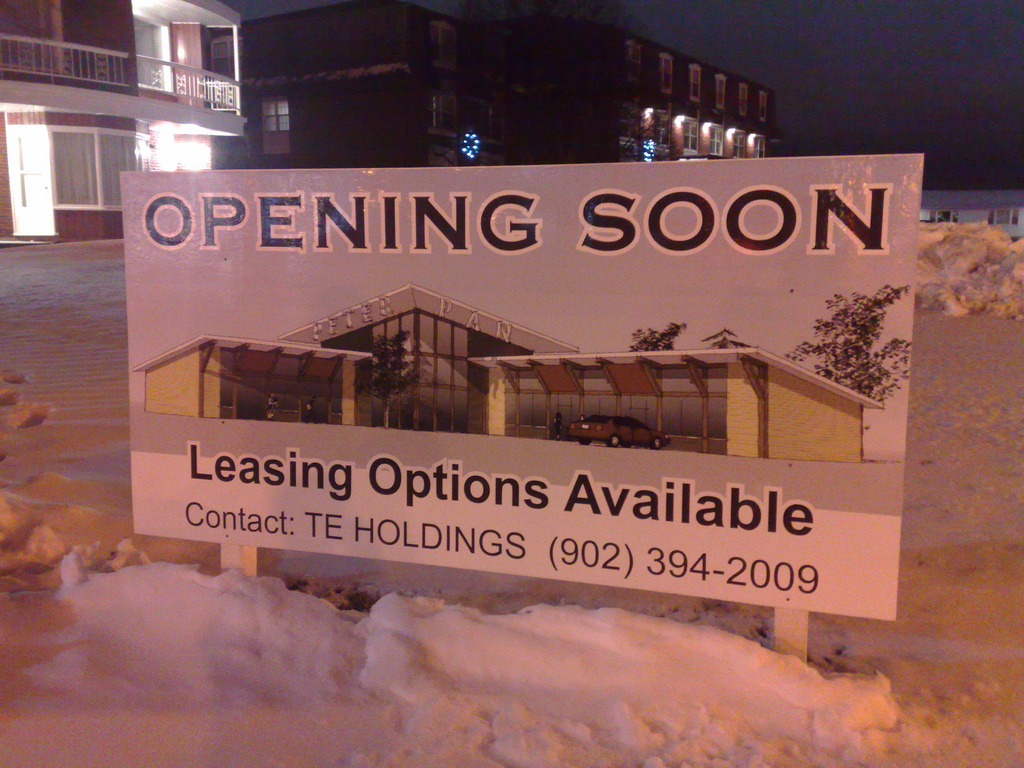
Back in the 1990s when you thought of Empire Theatres you’d picture a pokey regional film exhibitor with tiny, cramped theatres and a bad eye for picking films.
Things have changed: Empire has expanded out across the country through acquisition, has massively improved its theatres, and has adopted new web and payment technologies in a big way (it even uses Drupal to power its website).
It has even done away with the annoying “Hi, I’m Shawn, and I just want to let you know about some of the features of this theatre” performance by angsty teens and the full-on Stash your Trash advocacy that so inflamed the readers here 7 years ago.
Alas it still shows the same old Hollywood movies as the other guys, but what can you do.
My favourite new development at Empire is the option to buy paperless tickets from mobile devices. From its empiretheatres.mobi site (which renders quickly and well on both my iPod Touch and my Nokia N95), you simply select “Mobile Ticket” as the delivery option:
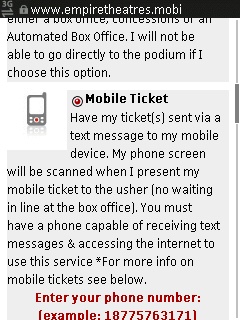
Once you’ve paid (Interac, credit card, gift card), you get a text message that looks like this:
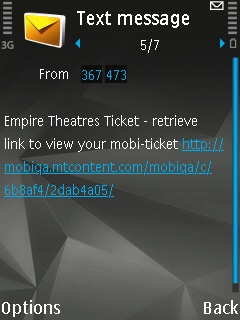
Opening that link in a mobile browser on the device displays a QR code that you simply present to the usher, who scans it and waves you on.
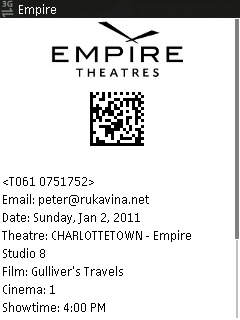
Scanning the barcode with the scanner on my Nokia N95 resolves it to the same number that’s shown text in the browser, in this case T061 0751751, which I presume is the key to looking up my record in the database accessed by the usher.
I’ve used the system twice now, and everything has gone smoothly, and it’s nice not to have to wait in line or fight with the slightly-out-of-alignment touchscreens in the lobby to buy tickets.
Gulliver’s Travels, on the other hand, was a total disappointment: Jack Black was running on School of Rock auto-pilot, the talents of the rest of the cast were wasted (Billy Connolly was left to bumble awkwardly), the emotional content to the story wasn’t believable (it’s not enough to rely on a stock “lowly guy in the mail room” conceit to power a romance-based plot), and while the technical wizardry that allowed Black to become a giant was impressive, it was the only interesting thing about the film, and wore thing after 30 minutes. What a wasted opportunity.
Here’s is the 2011 levee schedule for January 1, 2011 for Charlottetown and area. If you’re new to all of this and want to give it a try, read How to Levee. And if I’ve missed anything, please leave a comment.
All levee times and locations have been confirmed.
| THE LEVEE OF… | HELD AT… | STARTS | ENDS |
|---|---|---|---|
| Campbell Webster | Timothy’s World Coffee | 9:00 a.m. | 10:00 a.m. |
| Lieutenant Governor | Fanningbank (Government House) | 10:00 a.m. | 11:30 a.m. |
| City of Charlottetown | Charlottetown City Hall | 10:30 a.m. | 12:00 Noon |
| Canoe Cove | Canoe Cove Schoolhouse | 11:00 a.m. | 1:00 p.m. |
| University of PEI | McDougall Hall (at UPEI) | 11:00 a.m. | 1:00 p.m. |
| HMCS Queen Charlotte | 10 Water Street Parkway | 11:30 p.m. | 1:00 p.m. |
| Haviland Club | 2 Haviland Street | 11:30 a.m. | 12:30 p.m. |
| Town of Stratford | Stratford Town Centre | 12:00 Noon | 1:30 p.m. |
| Queen Charlotte Armouries | Foot of Haviland Street | 12:30 p.m. | 1:30 p.m. |
| Seniors Active Living Centre | CARI Pool Building | 12:30 p.m. | 2:00 p.m. |
| Masonic Temple | 204 Hillsborough St. | 1:30 p.m. | 3:00 p.m. |
| Reverend Richard Grecco | SDU Place (Bishop’s Palace) | 1:30 p.m. | 2:30 p.m. |
| Town of Cornwall | Cornwall Town Hall | 1:30 p.m. | 3:00 p.m. |
| Garden Home | 310 North River Road | 2:00 p.m. | 3:00 p.m. |
| Royal Canadian Legion | 99 Pownal Street | 2:00 p.m. | 3:00 p.m. |
| Handibear Hills | Sanctuary Barn, South Granville | 2:00 p.m. | 5:00 p.m. |
| Benevolent Irish Society | 582 North River Road | 3:00 p.m. | 5:00 p.m. |
| Premier Robert Ghiz | Confederation Centre of the Arts | 3:00 p.m. | 5:00 p.m. |
| Charlottetown Curling Club | 241 Euston Street | 4:00 p.m. | 6:00 p.m. |
| Sport Page Club | 236 Kent Street | 4:00 p.m. | 6:00 p.m. |
| Charlottetown Fire Department | Firemen’s Club | 4:30 p.m. |
New this year from the University of PEI: “All UPEI alumni and their friends are invited to ride the Panther Bus as it hops between all the major levees happening in Charlottetown on New Year’s Day.” And who among us doesn’t have a friend who’s a UPEI alumnus!
It’s been awhile since I turned my attention toward Plazes: since its acquisition by Nokia several years ago there’s been no evolution of the application, and I’ve been expecting Nokia to quietly pull the plug on it someday. I’m not sure anyone would notice.
In the meantime, I have a chance to pull out the 10,000-odd geolocations that I stored in Plazes from 2004 to 2009, and this provided me with an opportunity to experiment with Yahoo Query Language (YQL), which is a powerful tool that wraps an SQL-like querying functionality around data provided in XML and JSON from services like Plazes.
Step one using YQL with a new data source is to set up an Open Data Table for it; I did this for Plazes, wiring up the past_activities API method that provides access to a given user’s historical “plazings” and the result is at:
http://media.ruk.ca/plazes/archive/plazes.xml
Once this is in place, you can start to use the web-based YQL console to explore Plazes data. For example, if your Plazes userid is fiahless, you can go to the console and paste in the following text in the “Your YQL Statement” text field and click “Test”:
use "http://media.ruk.ca/plazes/archive/plazes.xml" as plazes; select * from plazes where userid = 'fiahless';
This will return the most recent 100 plazings for this user as XML. You can use any of the XML elements in the “where” part of your YQL query to limit your search. For example, this query will find my own recent plazings that have the word coffee in the status message:
use "http://media.ruk.ca/plazes/archive/plazes.xml" as plazes; select * from plazes where userid = 'ruk' and status like '%coffee%';
And this query will search my most recent 1,000 plazings and find those where the address of the place I checked in contains the word Prince:
use "http://media.ruk.ca/plazes/archive/plazes.xml" as plazes; select * from plazes(0,1000) where userid = 'ruk' and plaze.address like '%prince%';
You don’t need to configure anything to make this work for yourself; just use these queries as a starting point and start exploring using the YQL console yourself (note that if you get a Could not load table plazes from http://media.ruk.ca/plazes/archive/plazes.xml error from the console, just click Test again – there seems to be some sort of intermittent issue at YQL in retrieving external URLs at the moment).
Although it was overshadowed by our visit to Tipoteca the following week, it was not only the Italian take on the printing museum that we experienced during our trip to Europe: our first destination, to Basel, was inspired by the opportunity to visit Basler Papiermühle – the “Swiss Museum for Paper, Writing and Printing” – that’s located steps from the Rhine on Basel’s waterfront.

Like Tipoteca, the Papiermühle is a pleasantly “hands on” museum; while it’s not quite got the “you can try out anything” wonders of Tipoteca, it is full of opportunities to try out things like paper making, writing with a quill pen, setting type and printing.
Basler Papiermühle is a short 20-minute walk from central Basel; it’s in a very pleasant area of the city, and you might want to plan to spend extra time walking along the Rhine and visiting nearby art galleries and shops if you can.
We arrived at the museum on a bone-chillingly-damp Sunday afternoon; as it turns out, I’d read the information on the museum’s website incorrectly, and we were two hours early, as it doesn’t open until 2:00 p.m. We used the extra time to take a quick run through the nearby Museum für Gegenwartskunst and to have a quick lunch at the Papiermühle’s restaurant (very nice food; as shockingly expensive as eating out anywhere else in Basel).
When 2:00 p.m. arrived we were primed and ready for action. Our first stop was the paper making hall, where an actual water-mill-powered “beater” turns rag into pulp
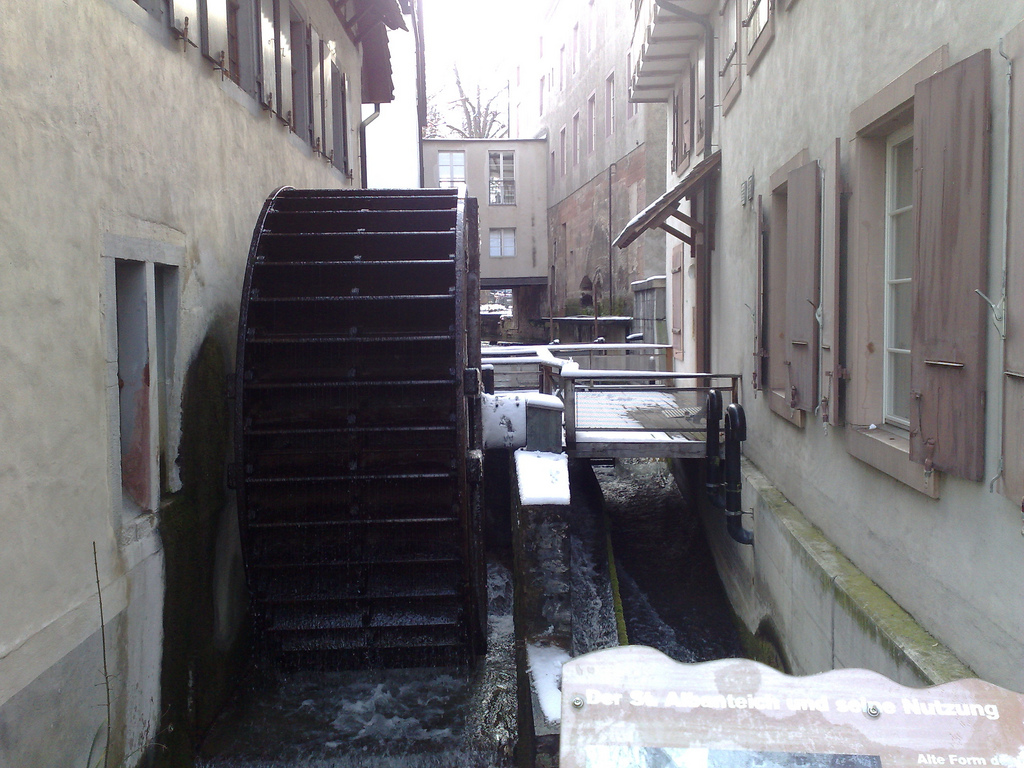
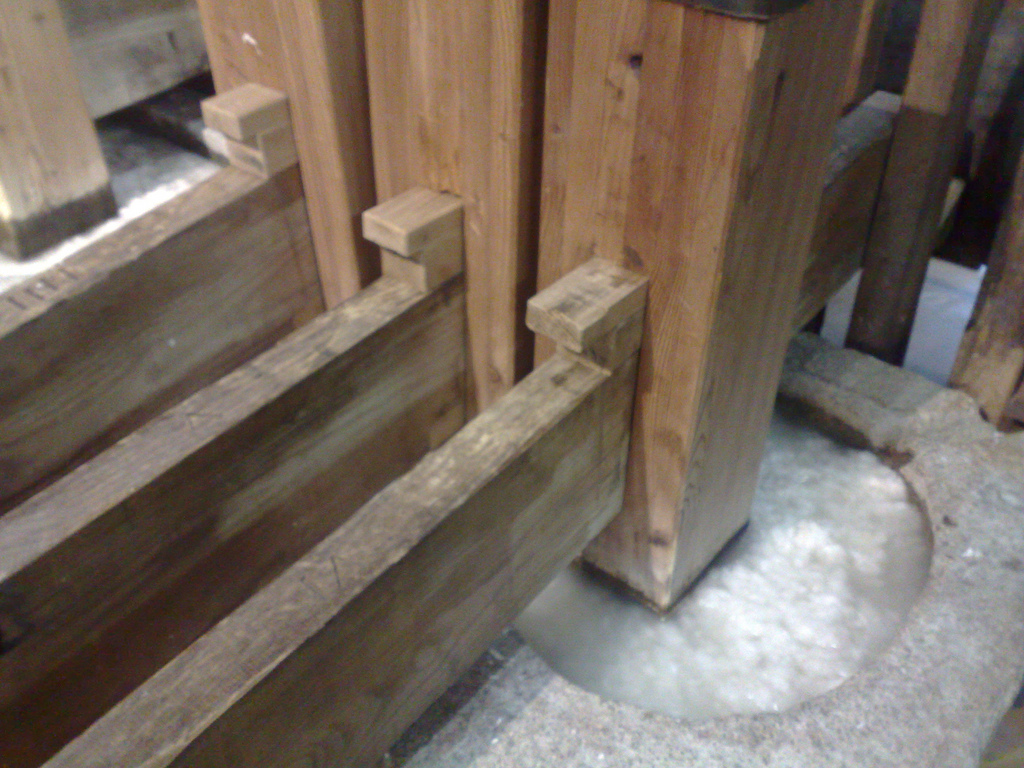
When the pulp comes out the other side, ready for turning into paper, visitors get in on the action, taking a screen, complete with the Papiermühle logo watermark, and dipping into the vat of pulp, evenly spreading pulp across the screen, and then removing from the water, turning over onto felt, and then squeezing the water out with a press:


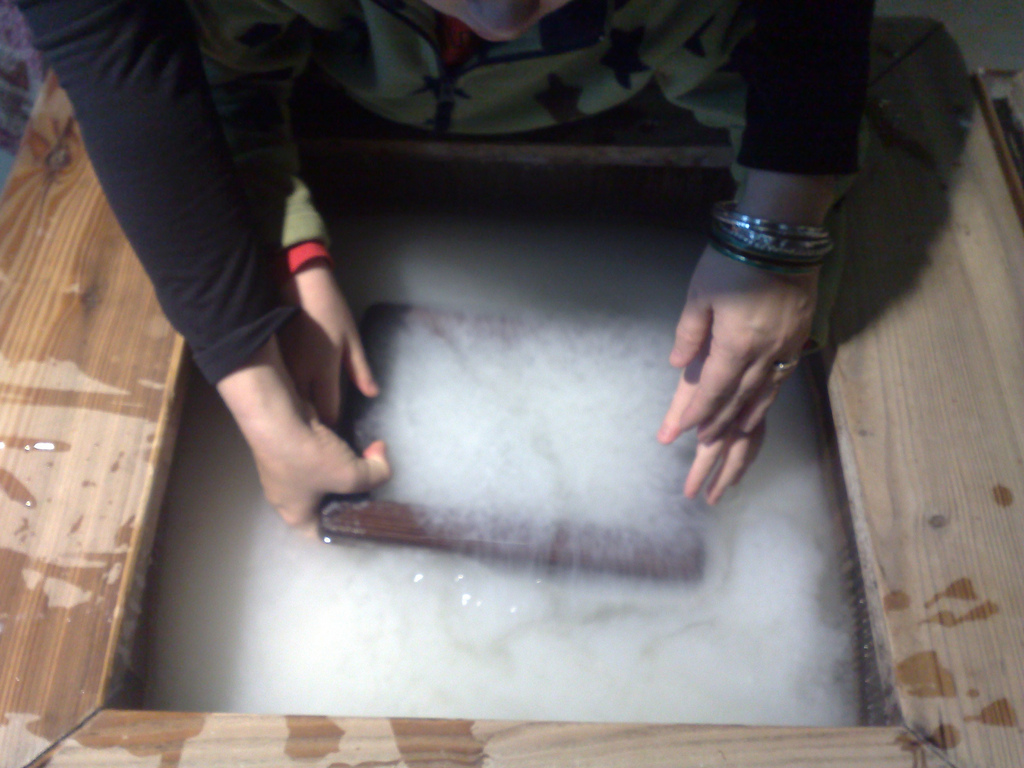
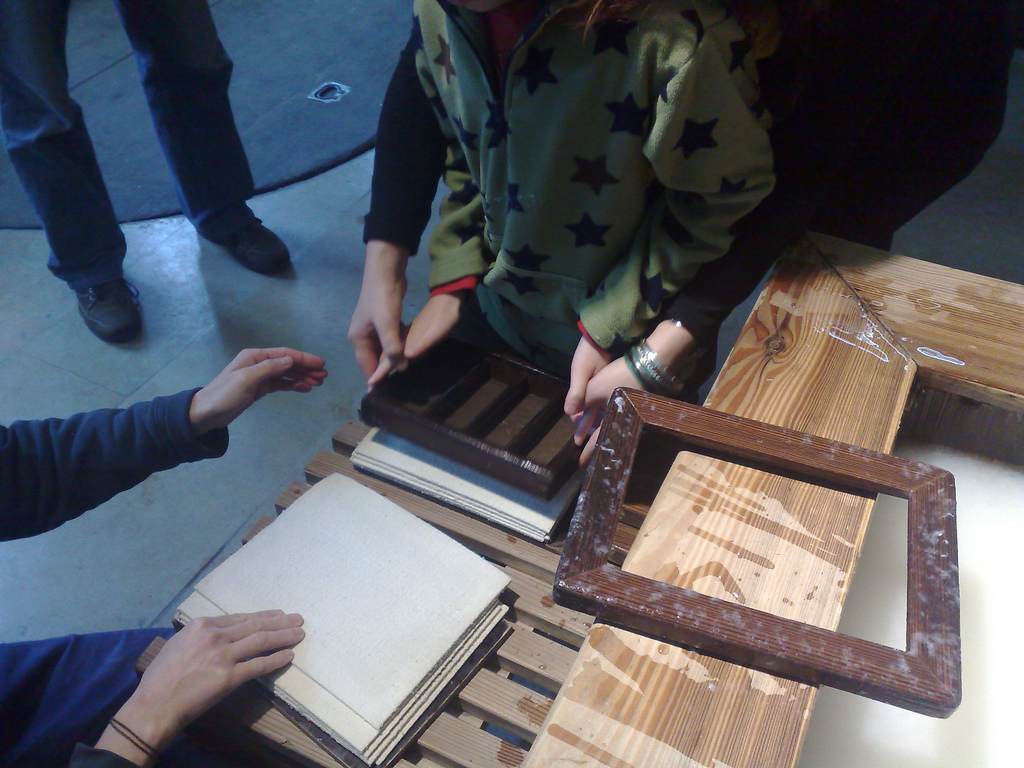
With the water removed the sheets of damp paper are placed in heat (inside something that looks like a T-shirt press) and a few minutes later they emerge as, well, paper. The effect is rather amazing, in part because the final product isn’t some weird paper-like creation, but rather something real that you’d be happy to write a letter home on.
Next step was the several rooms devoted to the art of writing. We got our names written in Chinese by a calligrapher, and then, in the next room, got to write a message with a quill pen, and then select a seal and hand it over to a woman who dribbled hot wax on the folded note and impressed the seal:
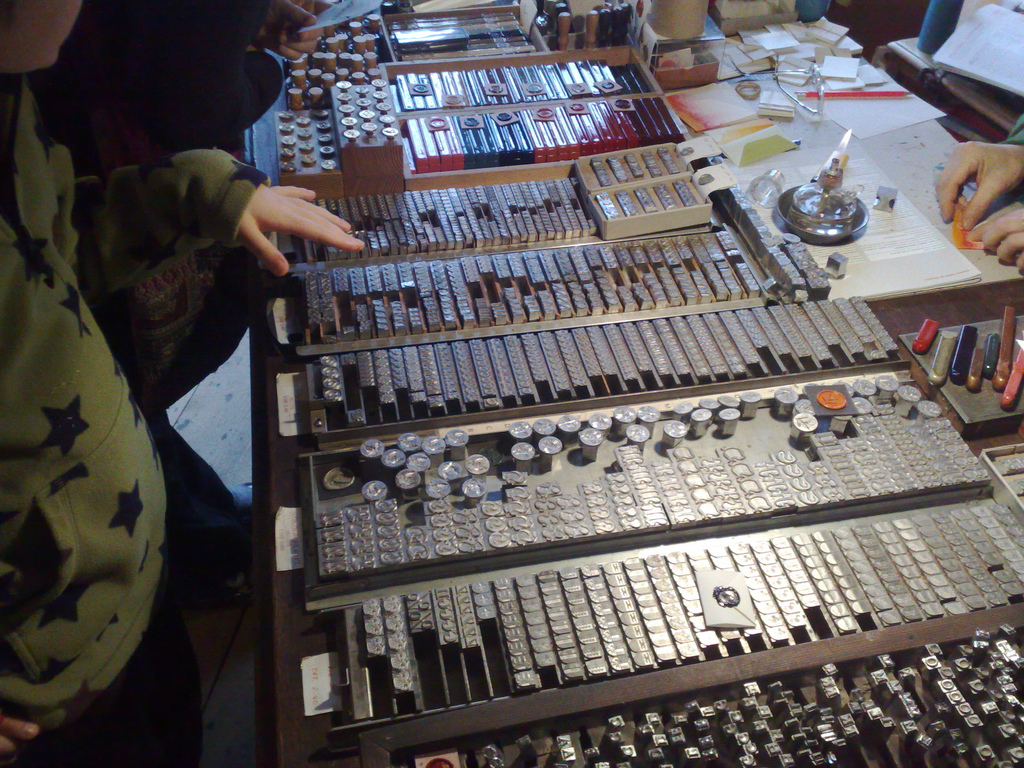
After writing came printing: the Papiermühle has an excellent collection of type, casting machines and presses along with exhibits illustrating the operating of each. The highlights of the printing exhibition were watching a man cast a Gutenberg-style letter “O” by hand from molten lead and, especially, the opportunity to set type and see it printed, much like a similar workshop at Tipoteca:
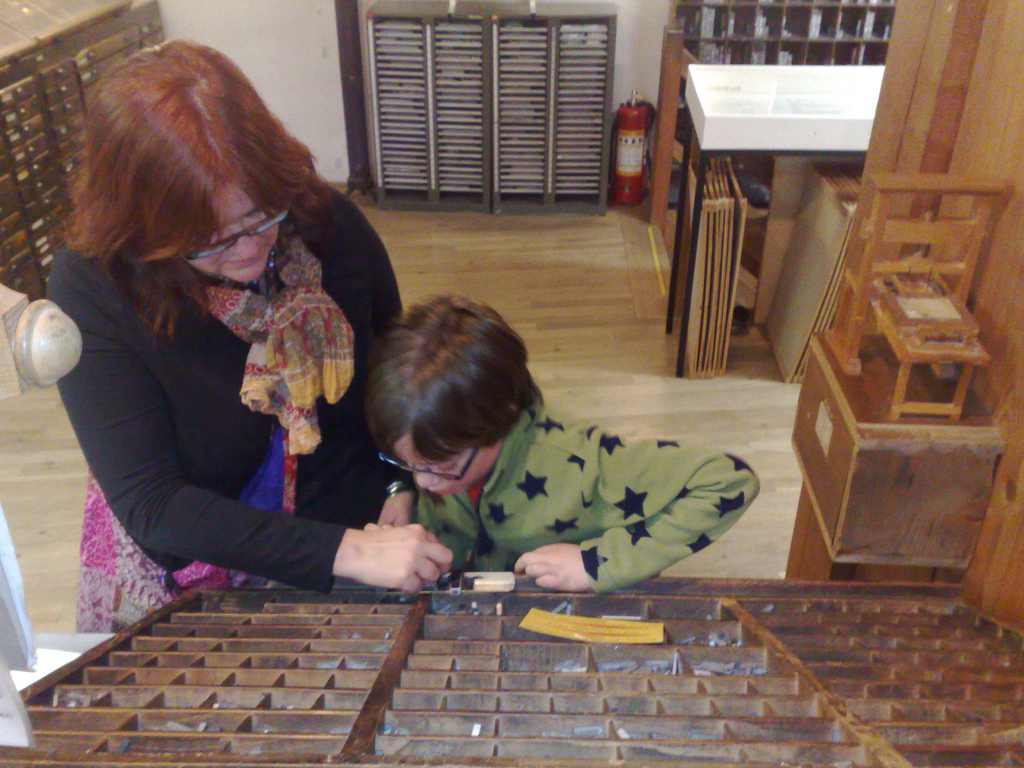
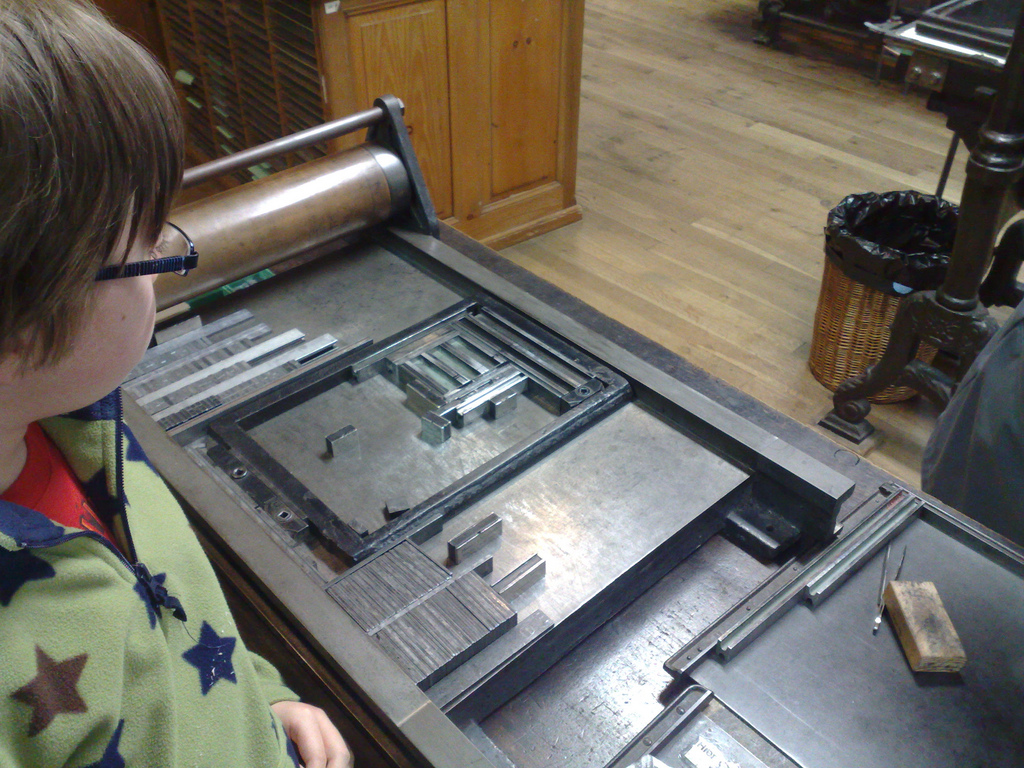
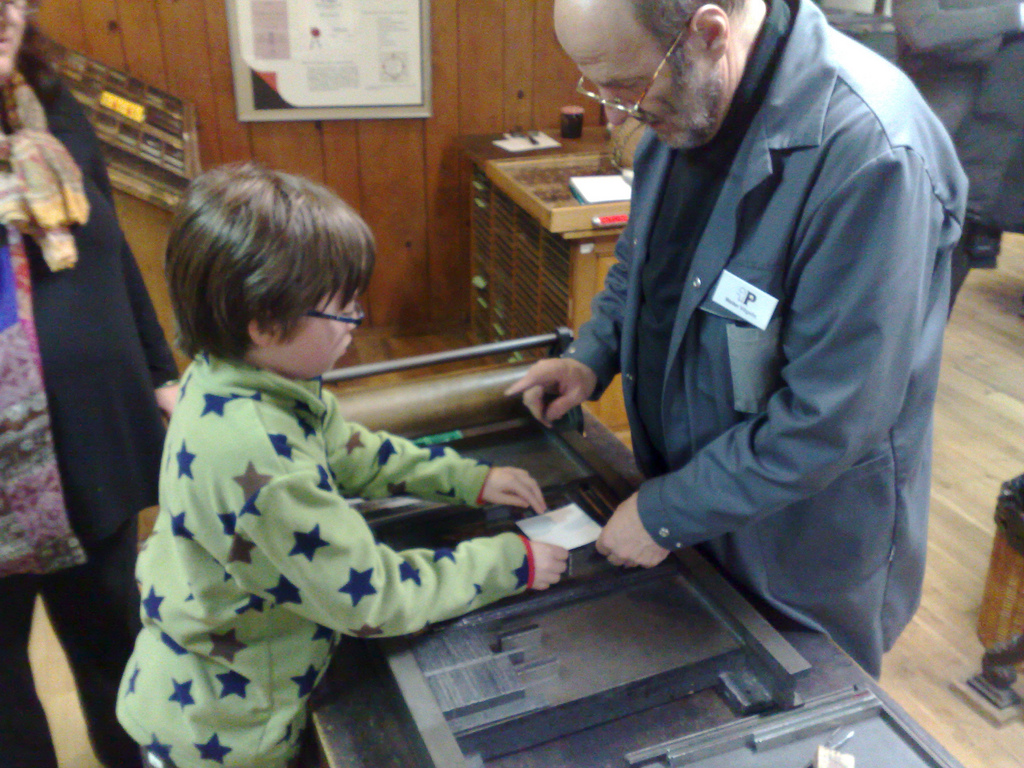
We also got the chance to try out a simple table-top platen press, and to explore the museum’s excellent collection of presses large and small.
From printing we finished up on the top floor with book binding, the only aspect of the museum that, alas, didn’t include a hand-on component, leaving us to simply watch a woman go through the process of assembling a book: interesting, but not as interesting as it would have been should we have been allowed to do it ourselves.
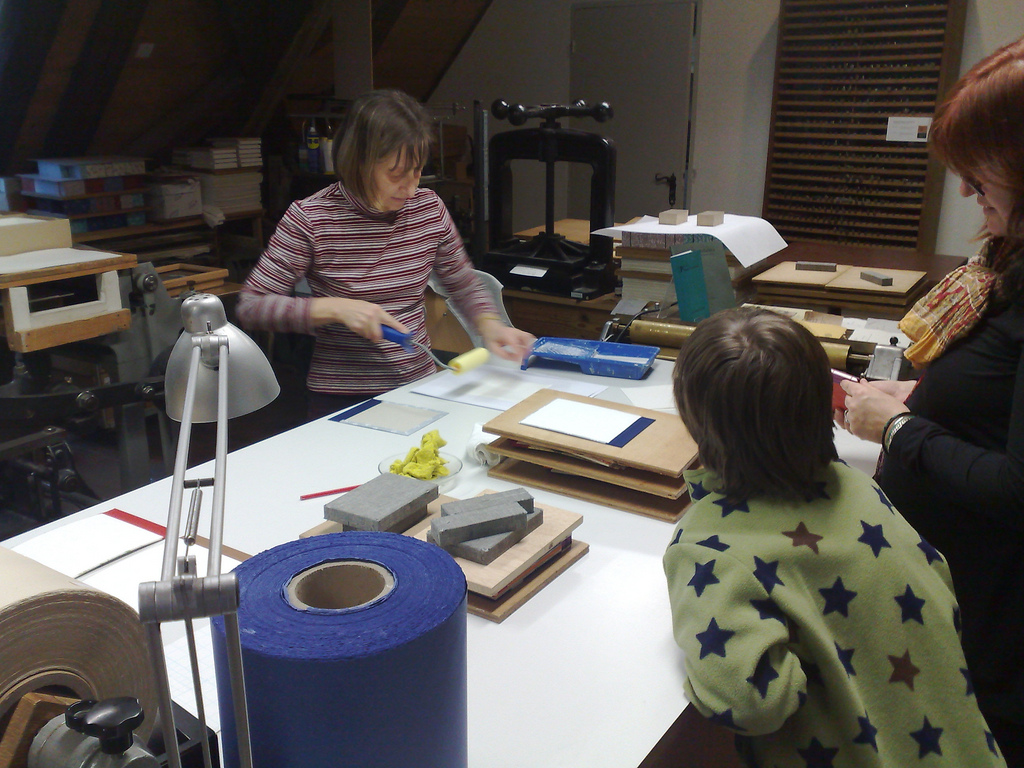
A quick trip through the museum bookshop (they have an online shop as well) and we were back into the chilly Basel evening.
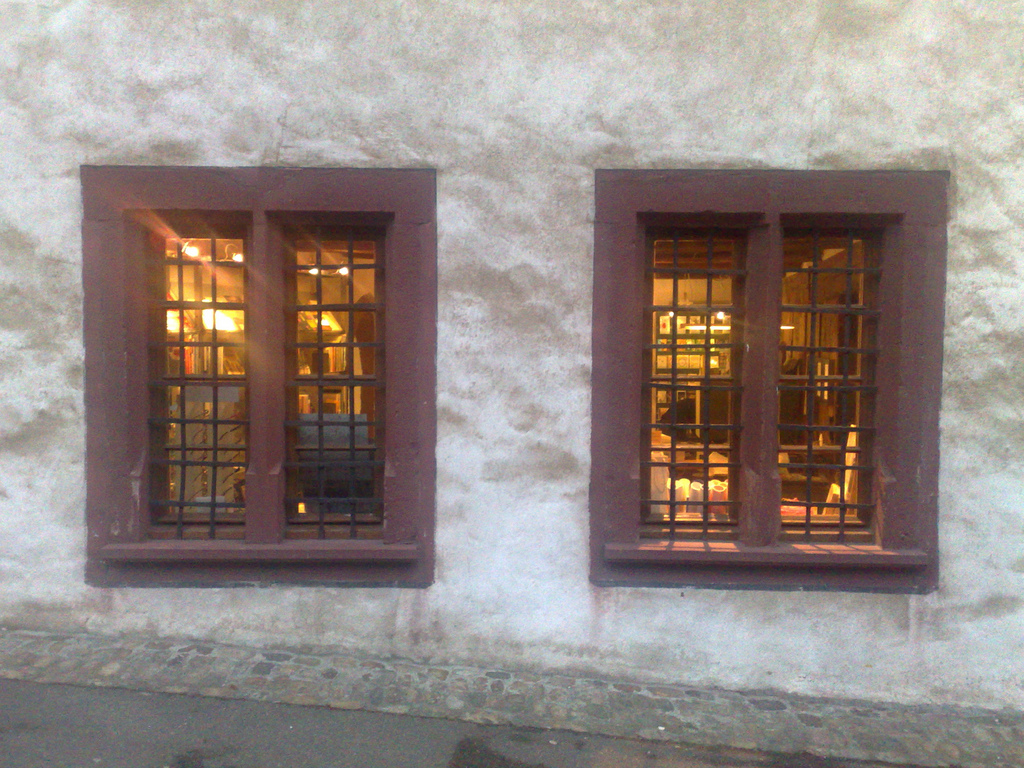
While the Basler Papiermühle is more “museumy” than Tipoteca, it’s still an excellent showcase for art and science of paper, writing, typesetting, printing and bookbinding, and if you’ve an interest in any of these, and an afternoon in Basel, I highly recommend a visit.
Still one of my favourite musical moments on Prince Edward Island: Garnet Rogers at the Trailside Café in Mount Stewart in the fall of 2007. For reasons I cannot recall I was the emcee. The night ended with a 20 minute version of Night Drive and Northwest Passage that I grabbed the audio of by setting my phone on the table. It was a transcendent performance. If you like this, please go and buy some of Garnet’s albums.
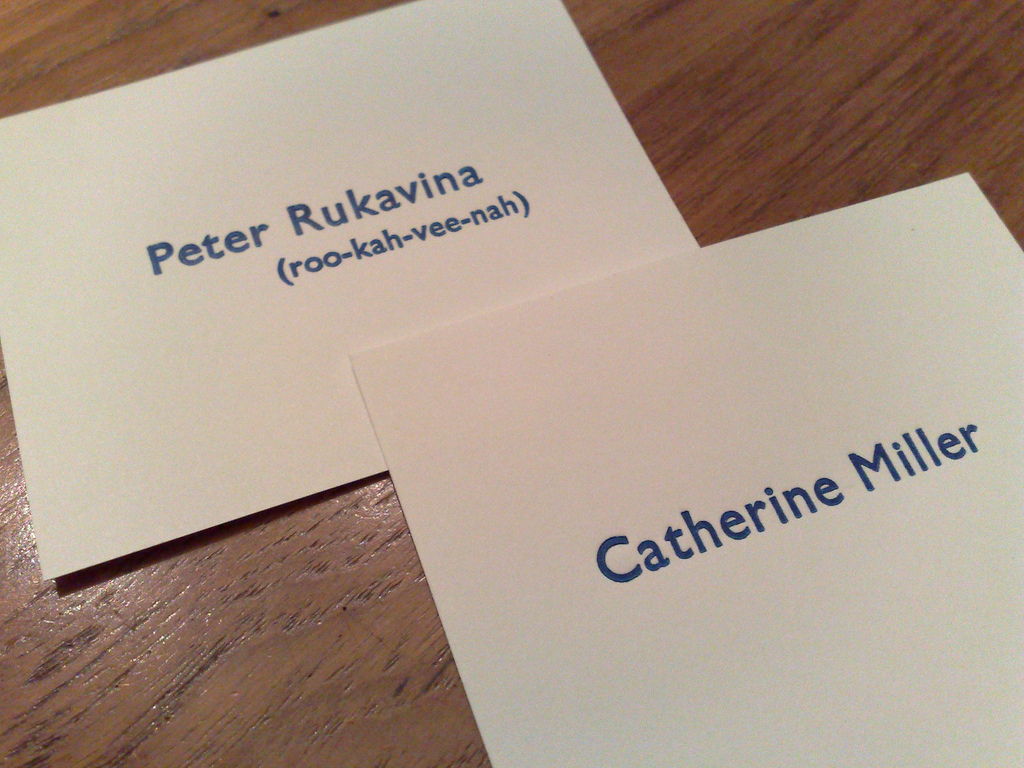
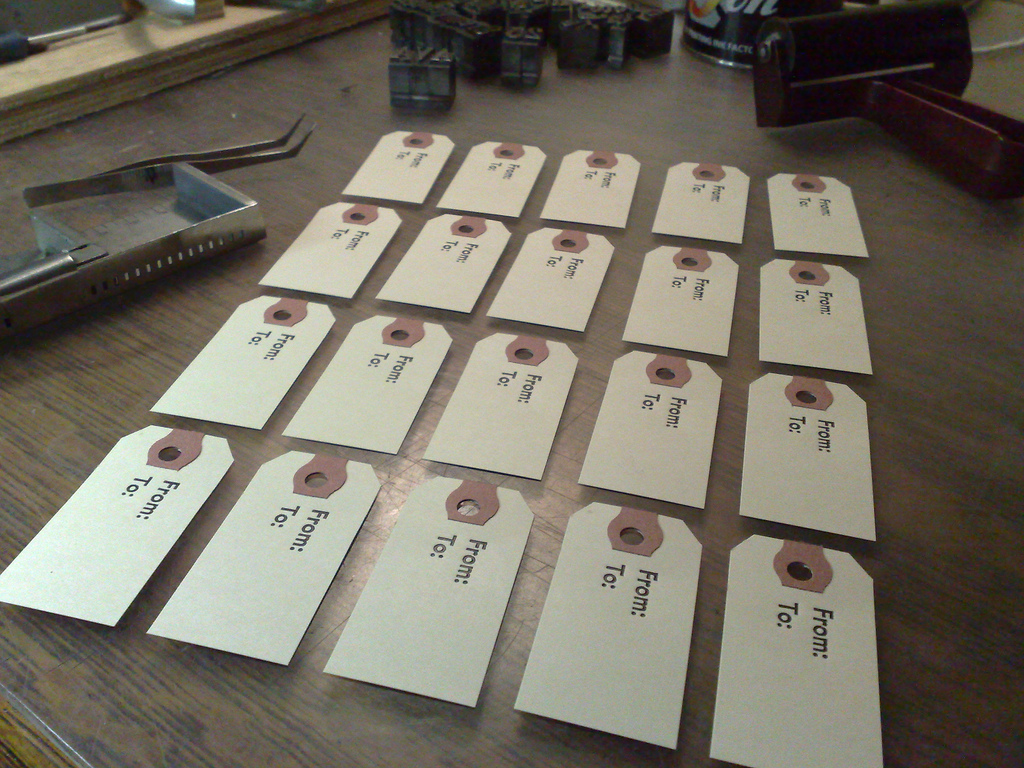
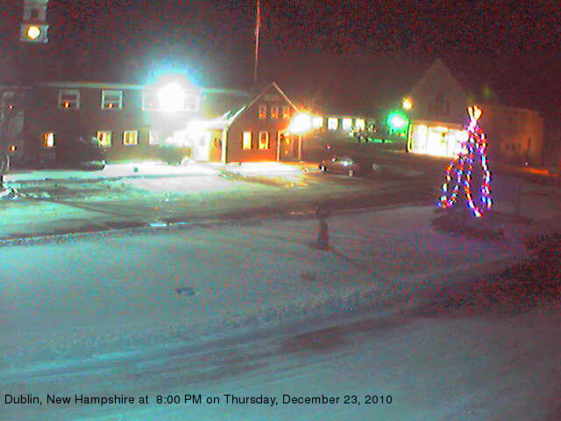
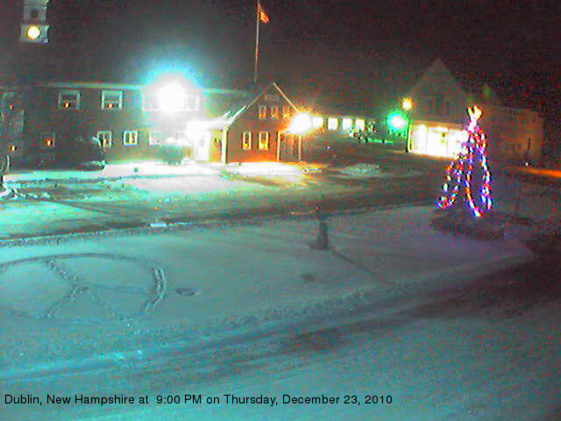
 I am
I am